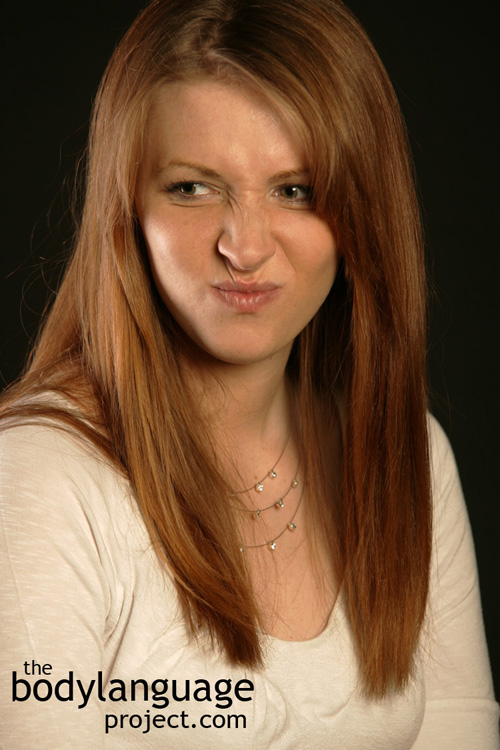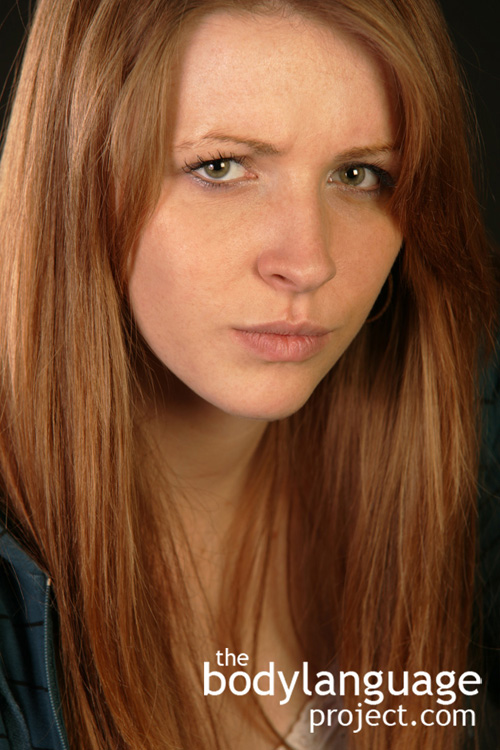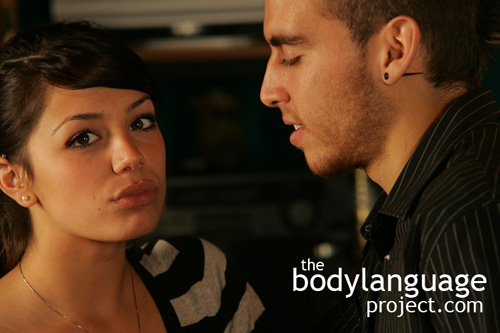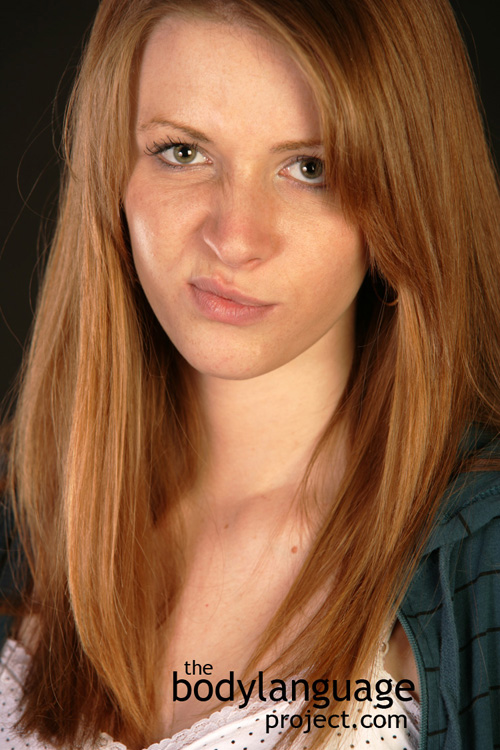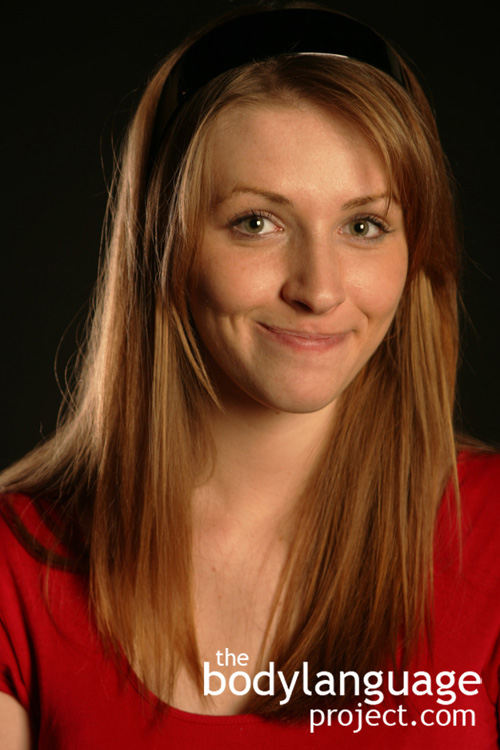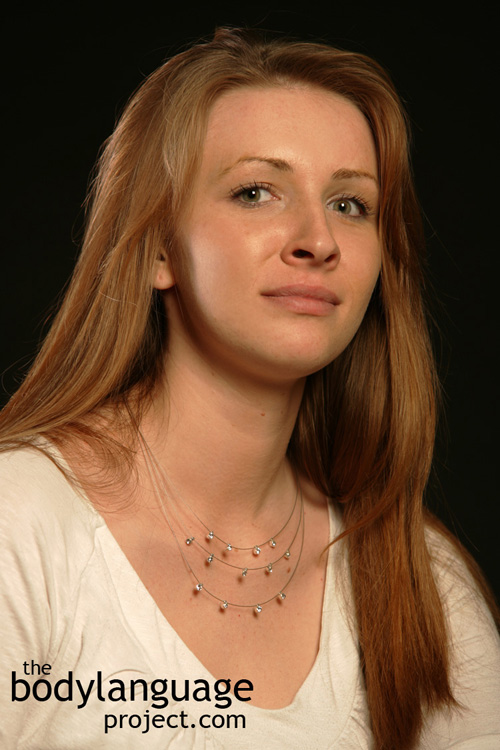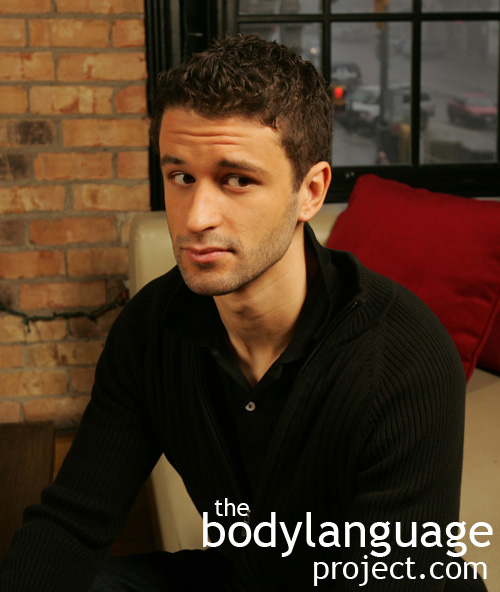Body Language of the Sneering
Synonym(s): N/A
Description: Sneering happens quickly, often in a split second, when the muscles between the eyes just above the nose contract forcing the skin around the nose to wrinkle and the brows to furrow. Sneers activate the buccinator muscles located on the sides of the face to draw the corners of the lips to twist sideways toward the ears.
In One Sentence: Sneering signals a negative thought.
How To Use it: Sneering can be used as a microexpression to signal disagreement so can operate just under conscious awareness. You may use the signal to show disapproval of a person or idea by flashing it upon their presence or just as they complete a thought.
Context: General.
Verbal Translation: “I don’t like what I’m seeing or hearing and my nose is wrinkling. It is as if I have experienced a bad odor.”
Variant: See Eye Rolling or Eye Shrug.
Cue In Action: The final card was dealt and Dave needed another 8 to complete his full house. It came in as a 6 of diamonds, not what he wanted. His nose crinkled momentarily as he stifled his disappointment.
Meaning and/or Motivation: This is an expression that usually happens in just seconds, it is not held for any length of time, and usually falls out of our direct control. For this reason, it is considered an honest expression, and loaded with hidden meaning. It signals a negative attitude and arrogance to views or persons to which it accompanies. Sneering, much like eye rolling, signifies dislike, contempt, arrogance, disapproval, disrespect, disgust or displeasure all over the world.
To visualize this cue imagine smelling something off-putting, the nose crinkles or wrinkles up, then relaxes. Sneering says, “I don’t care what you think, and I don’t respect you.” Because sneers happen as microexpressions, they often immediately follow a stimulus. This makes it very easy to link the negative expression with its cause.
Couples who sneer when listening to each other indicate that they lack respect and it has been shown that it is a good predictor for breaking up. Sneering can be done by employees who think they know more than their bosses, but whom resist speaking up because of fear of being fired, and by children who lack respect for authority. Wherever sneering rears its ugly face, it is due to distain.
Cue Cluster: Watch for other indicators of negative thoughts such as head shaking, yawning, finger pointing, overall tensing of the body or extreme body loosening to ready for fighting, tightening of the jaw and lips, quivering in the lips, frowning, furrowing, or lowering the eyebrows, dilated pupils, squinting of the eyes, crotch displays such as legs open, or flared nostrils.
Body Language Category: Aggressive body language, Anger body language, Dislike (nonverbal), Emotional body language, Hostile body language, Indicators of disinterest (IOD), Leaked or involuntary body language, Microexpressions, Negative body language, Rejection body language, Universal facial expressions.
Resources:
Aranguren, Martin. “Nonverbal interaction patterns in the Delhi Metro: interrogative looks and play-faces in the management of interpersonal distance.” Interaction Studies. 2016. 16(1) forthcoming.
http://bodylanguageproject.com/articles/seriously-stop-touching-use-nonverbal-signaling-manage-unwanted-touching-busy-public-areas/
Aranguren, Martin and Stephane Tonnelat. Emotional Transactions in the Paris Subway: Combining Naturalistic Videotaping, Objective Facial Coding and Sequential Analysis in the Study of Nonverbal Emotional Behavior. Journal of Nonverbal Behavior. 2014. 38:495–521. DOI 10.1007/s10919-014-0193-1
Carroll E. 1994. Innate and universal facial expressions: Evidence from developmental and cross-cultural research Izard, Psychological Bulletin. 115(2): 288-299.
Curtis V, Aunger R, Rabie T (2004) Evidence that disgust evolved to protect from risk of disease. Proceedings of the Royal Society of London, Series B 271: S131–S133. doi:10.1098/rsbl.2003.0144. PubMed: 15252963.
Curtis, V., & Biran, A. (2001). Dirt, disgust, and disease: Is hygiene in our genes? Perspectives in biology and medicine, 44(1), 17–31.
Carroll JM, Russell JA (1996) Do facial expressions signal specific emotions? Judging emotion from the face in context. J Pers Soc Psychol 70: 205–218. doi:10.1037/0022-3514.70.2.205. PubMed: 8636880.
Daniel H. Lee, Reza Mirza, John G. Flanagan and Adam K. Anderson. Optical Origins of Opposing Facial Expression Actions. Psychological Science published online 24 January 2014 DOI: 10.1177/0956797613514451
http://bodylanguageproject.com/articles/eyes-and-facial-expressions-may-be-biologically-controlled-serve-a-real-non-emotional-purpose-says-research/
Ekman, Paul. 1994. Strong evidence for universals in facial expressions: A reply to Russell’s mistaken critique Psychological Bulletin. 115(2): 268-287.
Ekman, Paul. 1986. A new pan-cultural facial expression of emotion. Source: Motivation and Emotion Ekman. 10(2): 159-168.
Ekman, Paul and Friesen, W. V. 1987. Universals and cultural differences in the judgments of facial expressions of emotion. Journal of Personality and Social Psychology. 53(4): 712-717.
Ekman, Paul; Friesen, Wallace V. 1971. Constants across cultures in the face and emotion. Journal of Personality and Social Psychology. 17(2): 124-129.
Ekman, Paul. 1972. Universals and cultural differences in facial expressions of emotion. In J. Cole (Ed.), Nebraska Symposium on Motivation, 1971. 19: 207-282. Lincoln: University of Nebraska Press.
Ekman, P. & O’Sullivan, M. (1991). Who can catch a liar? American Psychologist. 46, 913-920.
Fulcher, J. S. “Voluntary” facial expression in blind and seeing children. Archives of Psychology, 1942. 38: 272.
Friesen, W. V. 1972. Cultural differences in facial expressions in a social situation: An experimental test of the concept of display rules. Unpublished doctoral dissertation, University of California, San Francisco.
Gagnon, Mathieu ; Gosselin, Pierre ; Hudon-ven der Buhs, Isabelle ; Larocque, Karine ; Milliard, Karine. Children’s Recognition and Discrimination of Fear and Disgust Facial Expressions. Journal of Nonverbal Behavior. 2010. 34(1): 27-42.
Inbar, Y., & Pizarro, D. Disgust, politics, and responses to threat [commentary]. The Behavioral and Brain Sciences. 2014. 37: 315-316.
Inbar, Y., Pizarro, D.A., Iyer, R., and Haidt, J. (2012). Disgust sensitivity, political conservatism, and voting. Social Psychological and Personality Science. 2012. 3: 537-544.
Inbar, Y., Pizarro, D.A., and Bloom Disgusting smells cause decreased liking of gay men. Emotion. 2012. 12: 23-27.
Inbar, Y., Pizarro, D.A., & Bloom, P. Conservatives are more easily disgusted than liberals. Cognition and Emotion. 2009. 23, 714-725.
James A. Russell, Naoto Suzuki and Noriko Ishida. 1993. Canadian, Greek, and Japanese freely produced emotion labels for facial expressions. Motivation and Emotion. 17(4): 337 -351
Kunz, Miriam ; Peter, Jessica ; Huster, Sonja ; Lautenbacher, Stefan Gray, Marcus (Editor). Pain and Disgust: The Facial Signaling of Two Aversive Bodily Experiences (Comparing Facial Expressions of Pain and Disgust). 2013. 8(12): p.e83277.
McClure, Erin B 2000. A meta-analytic review of sex differences in facial expression processing and their development in infants, children, and adolescents
Psychological Bulletin. 126(3): 424-453.
Mead, M. 1975. Review of “Darwin and facial expression.” Journal of Communication, 25: 209-213.
Pizarro, D.A., Inbar, Y., and Helion, C.. On disgust and moral judgment. Emotion Revie2. 2011. 3: 267–268.
David Pizarro (video) talk about the possible evolution of the disgust facial expression: http://bodylanguageproject.com/articles/evolution-politics-disgust-ted-talk-david-pizarro/
Russell, James A. 1995. Facial Expressions of Emotion: What Lies Beyond Minimal Universality? Psychological bulletin. 118(3): 379-391.
Russell, James A. 1994. Is There Universal Recognition of Emotion From Facial Expression? A Review of the Cross-Cultural Studies. Psychological Bulletin. 115(1): 102-141.
Susskind, Joshua M and Adam K Anderson. Facial Expression Form and Function. Communicative Integrative Biology. 2008. 1(2): 148–149. PMCID: PMC2686004
http://bodylanguageproject.com/articles/emotional-facial-expressions-evolve/
Schnall, S., Haidt, J., Clore, G. L., & Jordan, A. H. (2008). Disgust as embodied moral judgment. Personality and Social Psychology Bulletin, 34, 1096–1109. doi:10.1177/0146167208317771.
Underwood, M. K.. Glares of Contempt, Eye Rolls of Disgust and Turning Away to Exclude: Non-Verbal Forms of Social Aggression among Girls. Feminism & Psychology. 2004 14(3): 371-375
Wen-Jing Yan; Qi Wu; Jing Liang; Yu-Hsin Chen and Xiaolan Fu. How Fast Are The Leaked Facial Expressions: The Duration of Micro-Expressions. Journal Nonverbal Behavior. 2013; 37:217–230 DOI 10.1007/s10919-013-0159-8
http://bodylanguageproject.com/articles/just-fast-leaked-micro-expressions/
Wolf K, Mass R, Ingenbleek T, Kiefer F, Naber D et al. (2005) The facial pattern of disgust, appetence, excited joy and relaxed joy: an improved facial EMG study. Scand J Psychol 46: 403-409. doi: 10.1111/j.1467-9450.2005.00471.x. PubMed: 16179022.

